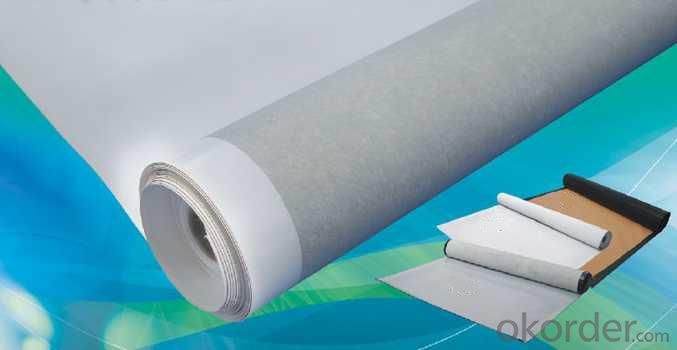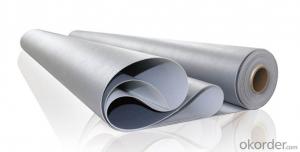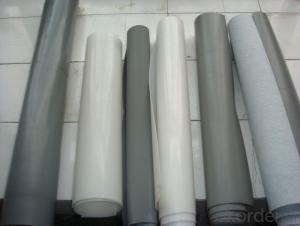PVC Plastic Waterproof Membrane for Underground
- Loading Port:
- China main port
- Payment Terms:
- TT OR LC
- Min Order Qty:
- 5000 m²
- Supply Capability:
- 100000 m²/month
OKorder Service Pledge
OKorder Financial Service
You Might Also Like
Specifications of PVC Plastic Waterproof Membrane
High tension , perfect elongation ,perfect heating resistance .
Perfect jointing , It can be fused with base as a whole after heatingjointing .
High permeability ,chilling material and moisture can be expelled easily .
High aging resistance, UV resistance , corrosion resistance and erosion resistance .
Good cold flexibility (-20°C).
Service life can reach 50 years long with no pollution .
Surface can reflect UV .The temperature on the surface is low due to little absorbing heat.
Product features:
The physical and mechanical properties of stability, durability and anti ageing capacity is good, its oil and solvent resistance and general-purpose chloroprene rubber be roughly the same.
1 Good heat resistance, cold resistance, can be in (-60-150 C) within the scope of use.
2 Extension and rate very high tear strength, shrinkage cracking of buildings or a strong ability to adapt.
3 The proportion of light (0.90~0.97), the appearance of uniform quality, has good flexibility and elasticity.
4 Good weldability, materials can be directly welded, is conducive to ensure weld quality. After welding to form an integral waterproof layer.
5 Good dimensional stability, heat shrinkage is small, the deformation is small, keep a good state during construction.
6 Environmental protection type. Does not produce harmful substances in the production, construction and use of the process, and can be recycled, does not produce construction waste.
Specification of EPDM Waterproofing Membrane
1 | Breaking Tensile Strength(Room temperature) | Mpa | ≥7.5 | |
2 | Breaking Tensile Strength 60℃ | Mpa | ≥2.3 | |
3 | Breaking Elongation(Room temperature) | % | ≥450 | |
4 | Breaking Elongation(-20℃) | % | ≥200 | |
5 | Tearing strength | KN/m | ≥25 | |
6 | Impermeability, 30min no leakage | -- | 0.3Mpa no leakage | |
7 | Low temperature bending | ℃ | ≤ -40 | |
8 | Heating shrinking | Extension | mm | ≤2 |
Shrink | mm | ≤4 | ||
9 | Heat resistance (80℃x168h) | Tensile strength | % | ≥80 |
Elongation retentions | % | ≥70 | ||
10 | Alkaline resistance, Ca(OH)2 solution, room temperature x168h | Tensile strength | % | ≥80 |
Elongation retentions | % | ≥80 | ||
11 | Ozone aging(40℃x168h) | Elongation40%, 500x10-2 | -- | Non-crack |
12 | Synthetic aging | Tensile strength | % | ≥80 |
Elongation retentions | % | ≥70 | ||
FAQ of EPDM Waterproofing Membrane
a.Can we get some samples before place order?
Answer: We can send the free samples to you by freight collect.
b.How many years can your PVC membrane guarantee?
Answer: We will guarantee the quality for 5 years at least.
c.Which countries you ever export the product?
Answer: We export the PVC membrane to South Africa, Middle east and even European countries.

- Q:How much does a waterproofing membrane cost?
- The price of a waterproofing membrane can fluctuate based on various elements. Elements such as the type of membrane, the area's size that needs to be waterproofed, and the intricacy of the installation can all influence the cost. Typically, the cost of a waterproofing membrane can vary between $1 and $5 per square foot. However, this estimation is merely a rough approximation and the actual cost can be either higher or lower depending on the factors mentioned above. To illustrate, a basic sheet membrane composed of PVC or EPDM may fall on the lower end of the price spectrum, whereas a liquid-applied membrane or a more advanced system like a bentonite clay membrane could be on the higher end. Furthermore, the size of the area requiring waterproofing will have an impact on the cost. Larger areas will necessitate more materials, labor, and time, which can escalate the overall price. The complexity of the installation is another aspect to consider. If the area is difficult to access or necessitates extensive preparation work, such as the removal of existing materials or the repair of cracks, the cost may increase. It is advisable to seek guidance from a professional waterproofing contractor who can evaluate your specific requirements, provide an accurate estimate, and recommend the most suitable waterproofing membrane for your project.
- Q:Can waterproofing membranes be used on metal surfaces?
- Yes, waterproofing membranes can be used on metal surfaces. Waterproofing membranes are designed to create a barrier that prevents water from penetrating surfaces, regardless of the material. Metal surfaces can be prone to corrosion and water damage, so applying a waterproofing membrane can help protect them from moisture and extend their lifespan. The type of waterproofing membrane used may vary depending on the specific needs and requirements of the metal surface, but there are various options available specifically designed for metal applications. These membranes are typically flexible, durable, and resistant to UV rays and other environmental factors, ensuring long-lasting protection for the metal surfaces.
- Q:Can a waterproofing membrane be used in crawl spaces?
- Yes, a waterproofing membrane can be used in crawl spaces to prevent moisture infiltration and protect the space from water damage.
- Q:Can a waterproofing membrane be used for water tanks and reservoirs?
- Yes, a waterproofing membrane can be used for water tanks and reservoirs. Waterproofing membranes are specifically designed to provide a barrier against water penetration, making them an ideal choice for protecting water tanks and reservoirs from leaks and seepage. These membranes are typically made of durable materials such as modified bitumen, PVC, EPDM, or TPO, which are resistant to water and can withstand prolonged exposure to moisture. The application of a waterproofing membrane on the walls and floors of water tanks and reservoirs creates a seamless and watertight seal, preventing any water loss or contamination. Additionally, these membranes can be customized to suit different types of water tanks and reservoirs, ensuring a perfect fit and maximum protection. Overall, using a waterproofing membrane is an effective and reliable solution for maintaining the integrity of water tanks and reservoirs and ensuring the safe storage of water.
- Q:SBS waterproofing membrane sub-class I and II when to use what level to use a secondary level
- Classification: According to physical indicators are divided into: Ⅰ (-20 ℃), Ⅱ (-25 ℃) type two categories; According to the fetal base can be divided into: polyester tires, glass fiber tire two categories; according to the surface material can be divided Waterproof sheet
- Q:Can a waterproofing membrane be applied to wood surfaces?
- Yes, a waterproofing membrane can be applied to wood surfaces. There are various types of waterproofing membranes available on the market, such as liquid membranes or sheet membranes, that can be specifically designed for wood surfaces. These membranes are typically made of materials like rubber, asphalt, or polyurethane, which provide a protective barrier against water and prevent moisture from penetrating the wood. The waterproofing membrane is applied to the wood surface using different methods, depending on the product, such as brushing, rolling, or spraying. Applying a waterproofing membrane to wood surfaces can help prolong the lifespan of the wood, prevent rotting or warping, and protect it from water damage. However, it is important to ensure proper surface preparation and follow the manufacturer's instructions for application to achieve the best results.
- Q:The difference between waterproof linoleum and waterproofing membrane
- Waterproof membrane is mainly used for building walls, roofs, as well as tunnels, highways, landfills, etc., to resist the external rain, groundwater leakage can be curled into a roll of flexible building materials, as the basis for engineering And no leakage between the building connection, the entire project is the first waterproof barrier, the entire project plays a vital role. The main products are asphalt waterproofing membrane and polymer waterproofing membrane.
- Q:What is the lifespan of a waterproofing membrane in extreme weather conditions?
- The lifespan of a waterproofing membrane in extreme weather conditions can vary depending on various factors such as the quality of the membrane, the intensity and duration of the weather conditions, and the maintenance and care provided to the membrane. In general, high-quality waterproofing membranes designed for extreme weather conditions can have a lifespan of 20-30 years or more. These membranes are typically made from durable materials such as modified bitumen, PVC, EPDM, or TPO, which are specifically engineered to withstand harsh weather elements. However, it is important to note that extreme weather conditions, such as heavy rain, intense sunlight, freezing temperatures, or strong winds, can accelerate the wear and tear of the membrane. For example, prolonged exposure to UV radiation can cause the membrane to degrade and lose its effectiveness over time. Regular maintenance and inspections are crucial to prolonging the lifespan of the waterproofing membrane in extreme weather conditions. By promptly addressing any signs of damage, such as cracks, tears, or leaks, and conducting regular cleaning and resealing, the membrane can be better protected against the harsh effects of extreme weather. Furthermore, proper installation techniques and following manufacturer's guidelines are essential to ensure the longevity of the waterproofing membrane. Hiring experienced professionals who are familiar with installing membranes in extreme weather conditions can greatly contribute to the durability and lifespan of the membrane. Ultimately, while a high-quality waterproofing membrane can withstand extreme weather conditions for several decades, it is important to monitor its condition regularly, provide proper care and maintenance, and promptly address any issues that arise to maximize its lifespan.
- Q:Are waterproofing membranes suitable for balconies and terraces?
- Yes, waterproofing membranes are suitable for balconies and terraces. These membranes are specifically designed to provide a protective barrier against water and moisture, preventing any potential damage to the structure of the balcony or terrace. Waterproofing membranes are typically made of materials such as rubber, bitumen, or PVC, which are highly resistant to water penetration. They are applied as a liquid, sheet, or spray, creating a seamless layer that covers the entire surface of the balcony or terrace. This ensures that no water can seep through and cause any structural issues, such as cracks, leaks, or deterioration. Additionally, waterproofing membranes can also protect against other forms of damage, such as mold growth or corrosion. Overall, using waterproofing membranes on balconies and terraces is an effective and recommended solution for maintaining their longevity and structural integrity.
- Q:Are there any specific considerations for installing a waterproofing membrane on sloped surfaces?
- Yes, there are several specific considerations for installing a waterproofing membrane on sloped surfaces. Here are a few important ones: 1. Proper slope: It is crucial to ensure that the slope of the surface is appropriate for drainage. The slope should be designed to allow water to flow away from the surface and prevent any pooling or ponding. This will help in avoiding water penetration and potential damage to the membrane. 2. Compatibility with slope materials: It is important to consider the compatibility of the waterproofing membrane with the materials used on the slope. This includes ensuring that the membrane adheres well to the slope surface and does not react negatively with any other materials present. 3. Anchoring and fastening: On sloped surfaces, proper anchoring and fastening of the waterproofing membrane is important to ensure its stability and longevity. This may involve using additional mechanical fasteners or adhesives specifically designed for sloped surfaces. 4. Transition and edge details: Sloped surfaces often have transition areas or edges where the waterproofing membrane meets other surfaces, such as walls or adjacent slopes. These areas require specific attention to ensure a proper seal and prevent any water infiltration. 5. Drainage systems: Sloped surfaces may require the installation of additional drainage systems to effectively manage water runoff. This may include the use of drains, gutters, or downspouts to divert water away from the waterproofing membrane. 6. Quality of installation: Installing a waterproofing membrane on a sloped surface requires careful attention to detail and proper installation techniques. It is important to follow the manufacturer's instructions and industry best practices to ensure a successful and durable installation. Overall, installing a waterproofing membrane on sloped surfaces requires a thorough understanding of the unique challenges and considerations involved. By addressing these specific factors, you can ensure effective waterproofing and protection for your sloped surface.
1. Manufacturer Overview |
|
|---|---|
| Location | |
| Year Established | |
| Annual Output Value | |
| Main Markets | |
| Company Certifications | |
2. Manufacturer Certificates |
|
|---|---|
| a) Certification Name | |
| Range | |
| Reference | |
| Validity Period | |
3. Manufacturer Capability |
|
|---|---|
| a)Trade Capacity | |
| Nearest Port | |
| Export Percentage | |
| No.of Employees in Trade Department | |
| Language Spoken: | |
| b)Factory Information | |
| Factory Size: | |
| No. of Production Lines | |
| Contract Manufacturing | |
| Product Price Range | |
Send your message to us
PVC Plastic Waterproof Membrane for Underground
- Loading Port:
- China main port
- Payment Terms:
- TT OR LC
- Min Order Qty:
- 5000 m²
- Supply Capability:
- 100000 m²/month
OKorder Service Pledge
OKorder Financial Service
Similar products
New products
Hot products
Related keywords




























